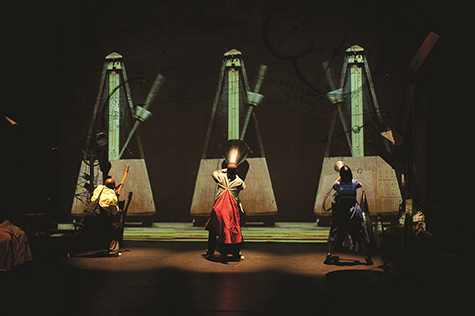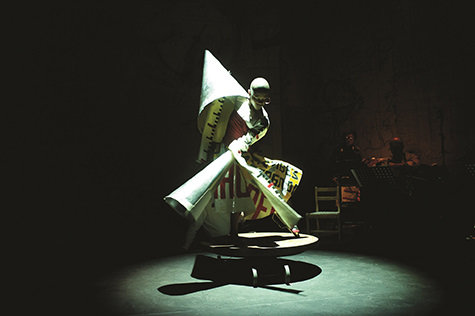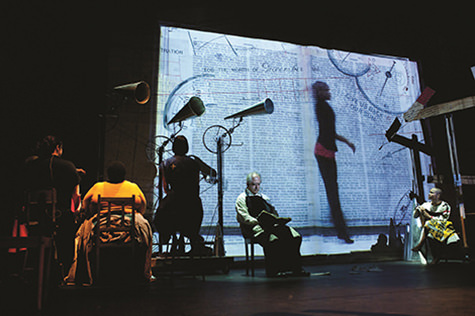Perth International Arts Festival: Modernism repackaged?
Jonathan Marshall: William Kentridge, Refuse the Hour

Refuse the Hour
photo John Hodgkiss
Refuse the Hour
In Refuse The Hour, visual artist William Kentridge and composer Philip Miller transform their installation The Refusal Of Time into an abstract, operatic work of the German muzik theater tradition. Kentridge himself appears, delivering rambling monologues on how we experience time in the wake of the invention of photography (1839), cinematography (1894), relativistic science (1905), telegraphy (1830s), railway travel (1820s), the international standardisation of time (1840+) and other developments in the history of Modernism.
The piece is an energetic, scattershot chamber work, overflowing with action. As a small cabaret ensemble plays, dancer Dada Masilo turns, flips and rotates in surprising loops about her ever supple hips, Ann Masina moves from singing Bizet to delivering a resonant defence of the right of locals to set midday according to their own local conditions (“Give us back our sun!” she exhorts at different registers), while Joanna Dudley performs vocal flights of fancy, sprechstimme and near-concrete poetry (at one point she reconfigures Masina’s text into assonant nonsense combinations). Actor Thato Motlhaolwa and the musicians often also move centrestage to join in.
Kentridge’s trademark films of charcoal-drawn animations, stuttering black and white filmic fantasies and ripped fragments of books, maps and text in motion, also appear, most of these adapted from the earlier installation. The stage features an assortment of antique-looking contraptions and noise-makers, notably a mechanised drumkit suspended from the ceiling, and numerous megaphones through which the singers holler and which also have speakers lodged in them. Singing, Dudley holds one of these at her waist; after a small delay, a distorted, processed version of the same is emitted. Techniques like the use of an acoustically amplified violin (a stroh, or horn violin) such as were employed in 1900s recording studios render the production of sound very much a spatial and theatrical event.

Refuse the Hour
photo John Hodgkiss
Refuse the Hour
The mixed cast performs in a way which neither obfuscates racial and ethnic origins, nor focuses on them. Masilo’s dance synthesises African elements into a multidirectional fluidity and African percussion contributes to songs and interludes. Apart from noting that the enforcement of clock-based time was central to colonialism, Kentridge elides his status as a post-Apartheid artist emerging from South Africa’s fraught history. The presence of a weighty, charismatic, cerebral white man who speaks for humanity as he stands beside a slight, mute, black, female dancing body does nevertheless rankle.
The history within which Kentridge places his work is, however, ultimately European and global far more than it is regional or specific. Indeed, he makes obsessive reference to those Euro-American artists who responded to international Modernism and its effects. His videos have long recalled the work of early filmmakers such as Georges Méliès, here represented by a sequence set in a Faustian astronomer’s laboratory. Kentridge’s illustrations are straight out of German Expressionism and woodblock prints of 1880-1935. The overall mode of Refuse the Hour is Dada or Futurist cabaret, with its blend of performance art, projections, faux-lecture, sculptural elements, vaudevillian action, and sense of play. Dudley is fitted out as a “New Woman” of the 1920s, complete with page-girl haircut and a simple, angular, blue dress. Masilo’s costume is adorned with red and black Russian script in Constructivist style, though no reference to Russia or revolutionary Socialism occurs. In one attractive tableau, Masilo places her arms and legs into the megaphones and is rotated by Kentridge on a small round platform, literally embodying Bauhaus dramaturg Oskar Schlemmer’s figure The Abstract from his Triadic Ballet (1912-32).

Refuse the Hour
photo John Hodgkiss
Refuse the Hour
Moreover, in a film Masilo appears as Loïe Fuller in the latter’s signature Serpentine Dance (an 1894 imitation of which was famously filmed for Edison), complete with batons under her dress to manipulate the fabric in swirls about her. Although much of Miller’s score has a delicate, fractured gestural quality punctuated by brass flourishes, several sections felt like Berthold Brecht and Kurt Weil’s Threepenny Opera (1928), with their wheezing, corrupted music-hall feel.
William Kentridge’s genius is to popularise historic Modernist avant-gardism via his immersive installations, but I wonder what he adds? Relativity has inspired everyone from Marinetti to Robert Wilson and Phillip Glass, and as far as relativistic multimedia opera goes, the familiarity of Refuse the Hour’s language lacks the wondrous sense of mystery which the recent revival tour of Einstein on the Beach maintained. While the sculptural formalism of performance art means that logical associations can be loose, Refuse the Hour seems dramaturgically dissolute. Its thematic links function at a level of high generality, and the alternation of monologue with explosive action produces a remarkably predictable rhythm. Refuse the Hour is immensely enjoyable, but I question the critical positioning of Kentridge as an equal among those whose work he so effectively sews together.
See William Kentridge speak about Refuse the Hour and excerpts of the work here and here.
–
Perth International Arts Festival 2016, Refuse the Hour, by William Kentridge, composer Philip Miller, dancer Dada Masilo, video design Catherine Meyburgh; Perth Concert Hall, 12-14 Feb
RealTime issue #131 Feb-March 2016






